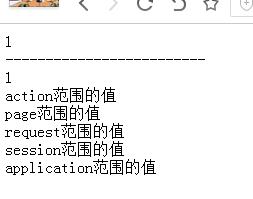Struts2--标签tag
Posted Ouka傅
tags:
篇首语:本文由小常识网(cha138.com)小编为大家整理,主要介绍了Struts2--标签tag相关的知识,希望对你有一定的参考价值。
在Struts2框架中提供了一套标签库,可以与struts2无缝结合。
数据标签a、action、bean、date、debug、i18n、include、param、property、push、set、text、url
控制标签:if、elseif、else、append、generator、interator、merge、sort、subset
简单实例
property:用来取得值桟中的值。

<s:push value="myBean"> <!-- Example 1: --> <s:property value="myBeanProperty" /> <!-- Example 2: escapehtml :表示是否跳过html,默认为true -->TextUtils <s:property value="myBeanProperty" default="a default value" escapeHtml=“false”/> </s:push>
param:用来给其他标签传入参数
|-name:参数的名字
|-value:参数的值
|-suppressEmptyParameters:是否压缩空参数
set:用来声明一个在特定作用于的变量
作用域有:application、session、request、page、action
几个属性:
|-scope:作用域,默认是action
|-value:变量的值
|-var:变量的名字
*注意变量值的地方需要在双引号里面加单引号

<%@ page language="java" pageEncoding="UTF-8"%> <%@ taglib prefix="s" uri="/struts-tags" %> <!DOCTYPE html PUBLIC "-//W3C//DTD HTML 4.01 Transitional//EN" "http://www.w3.org/TR/html4/loose.dtd"> <html> <head> <title>Insert title here</title> </head> <body> <s:set var="i" value="1"></s:set> <s:property value="#i"/><br/> <s:set var="xx" value="#i" scope="session"/> <s:set var="a" value="\'application范围的值\'" scope="application"/> <s:set var="s" value="\'session范围的值\'" scope="session"/> <s:set var="r" value="\'request范围的值\'" scope="request"/> <s:set var="p" value="\'page范围的值\'" scope="page"/> <s:set var="ac" value="\'action范围的值\'" scope="action"></s:set> -------------------------<br/> <s:property value="#session.xx"/><br/> <s:property value="#ac" /><br/> <s:property value="#attr.p" /><br/> <s:property value="#request.r" /><br/> <s:property value="#session.s" /><br/> <s:property value="#application.a"/><br/> </html>
输出结果:

bean:用来定义一个java bean
|-name:bean的全路径类名字
|-var:定义的javabean的名字

package com.fuwh.model; public class Student { private int id; private String name; public int getId() { return id; } public void setId(int id) { this.id = id; } public String getName() { return name; } public void setName(String name) { this.name = name; } }

<%@ page language="java" pageEncoding="UTF-8"%> <%@ taglib prefix="s" uri="/struts-tags" %> <!DOCTYPE html PUBLIC "-//W3C//DTD HTML 4.01 Transitional//EN" "http://www.w3.org/TR/html4/loose.dtd"> <html> <head> <title>Insert title here</title> </head> <body> <s:bean name="com.fuwh.model.Student" var="student"> <s:param name="id" value="2"></s:param> <s:param name="name" value="\'张三\'"></s:param> </s:bean> -------------------------<br/> <s:property value="#student.id"/> <s:property value="#student.name"/> </body> </html>
执行结果:

date:用不同的方式格式化日期
|-fromat:指定日期显示格式
|-name:需要被格式化的日期的值
|-nice:是否nicely的打印日期
|-timezone:格式化日期的时区
|-var:引用值桟中的日期

<%@ page language="java" pageEncoding="UTF-8"%> <%@ taglib prefix="s" uri="/struts-tags" %> <%@ page import="java.util.*" %> <!DOCTYPE html PUBLIC "-//W3C//DTD HTML 4.01 Transitional//EN" "http://www.w3.org/TR/html4/loose.dtd"> <html> <head> <title>Insert title here</title> </head> <body> <% request.setAttribute("date",new Date()); %> -------------------------<br/> ${date }<br/> <s:date name="#request.date" format="yy-MM-dd hh:mm:ss"/> </body> </html>
输出结果:

debug标签:可以输出值桟中的值
<s:debug></s:debug>
url和a标签
url:创建一个url变量,可以在里面 用param标签来传入参数
a:创建一个url
includ:用来引入别的资源
<s:include value="head.jsp"></s:include>
控制标签
if,elseif,else

<%@ page language="java" pageEncoding="UTF-8"%> <%@ taglib prefix="s" uri="/struts-tags" %> <%@ page import="java.util.*" %> <!DOCTYPE html PUBLIC "-//W3C//DTD HTML 4.01 Transitional//EN" "http://www.w3.org/TR/html4/loose.dtd"> <html> <head> <title>Insert title here</title> </head> <body> <% int age=18; request.setAttribute("age", age); %> <s:if test="#request.age>18"> 已经成年 </s:if> <s:elseif test="#request.age<18"> 还没成年 </s:elseif> <s:else > 刚好年芳18 </s:else> </body> </html>
iterator:用来循环输出
|-begin:循环输出的开始下标,默认0
|-end:循环输出的结束下标
|-status:代表下一个要被输出的
|-step输出的每次跳跃多少
|-value:被遍历的对象
|-var:代表每个取出的变量

<%@ page language="java" pageEncoding="UTF-8"%> <%@ taglib prefix="s" uri="/struts-tags" %> <%@ page import="java.util.*" %> <%@ page import="com.fuwh.model.*"%> <!DOCTYPE html PUBLIC "-//W3C//DTD HTML 4.01 Transitional//EN" "http://www.w3.org/TR/html4/loose.dtd"> <html> <head> <title>Insert title here</title> </head> <body> <% List<Student> stuList=new ArrayList<Student>(); stuList.add(new Student(1,"fuwh")); stuList.add(new Student(2, "zhangsan")); stuList.add(new Student(3, "lisi")); request.setAttribute("stuList", stuList); %> <table> <tr> <th>编号</th> <th>学号</th> <th>名字</th> </tr> <s:iterator value="#request.stuList" var="student" status="status"> <tr> <td><s:property value="#status。index+1"/></td> <td><s:property value="#request.student.id"/></td> <td><s:property value="#request.student.name"/></td> </tr> </s:iterator> </table> </body> </html>
append:把输出的对象叠加起来
|-var:代表叠加后的对象名

<%@ page language="java" pageEncoding="UTF-8"%> <%@ taglib prefix="s" uri="/struts-tags" %> <%@ page import="java.util.*" %> <%@ page import="com.fuwh.model.*"%> <!DOCTYPE html PUBLIC "-//W3C//DTD HTML 4.01 Transitional//EN" "http://www.w3.org/TR/html4/loose.dtd"> <html> <head> <title>Insert title here</title> </head> <body> <% List<Student> stuList=new ArrayList<Student>(); stuList.add(new Student(1,"fuwh")); stuList.add(new Student(2, "zhangsan")); stuList.add(new Student(3, "lisi")); request.setAttribute("stuList", stuList); List<Student> stuList2=new ArrayList<Student>(); stuList2.add(new Student(1,"fuwh")); stuList2.add(new Student(2, "zhangsan")); stuList2.add(new Student(3, "lisi"));以上是关于Struts2--标签tag的主要内容,如果未能解决你的问题,请参考以下文章
